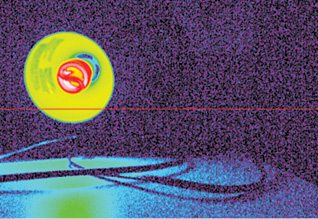
Available in wired and wireless versions, the broader dynamic range of this device coupled with SubMiniature version A (SMA) input connector enables it to also function as a pico ammeter. ILT5000 comes with a detachable antenna that allows it to send data at the rate of 16 readings per second. As with almost any new measurement device manufactured today, this instrument comes with a mini universal serial bus (USB) port for powering the device, data transfer as well as battery-charging purposes.
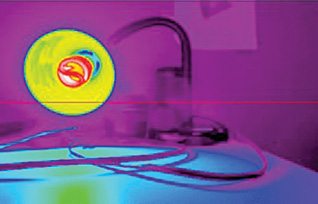
Photometers are widely used in the development and testing LED, lighting and in-vehicle lighting applications. With better cameras embedded inside photometers, these can provide a wider dynamic range, thereby reducing image-noise levels. See the difference in Figs 5 and 6.
For very high accuracy measurements, SphereOptics introduced a new feature known as high-dynamic-range (HDR) mode for their I-Series and Y-Series ProMetric imaging photometers. For a more accurate luminance analysis, this feature can be used on a device under test to attain the lowest and highest light-illumination levels. Considering streetlights as an example of the device under test, HDR mode in I-Series and Y-Series ProMetric imaging photometers can be used to measure the illumination pattern and light directly emitted from these.
Another imaging-measurement system for quick recording of colour distributions and luminescence, Konica Minolta Sensing Americas’ (KMSA) and Instrument Systems’ LumiCam 1300 Advanced can be used particularly for narrow-band LED colour-light measurements in today’s controls and displays to meet extremely high requirements. It boasts of a unique camera concept, which uses two filters having six optical filters in total.
Lighting professionals can make use of this concept for highly accurate measurements while analyzing the characteristics of display and control elements in vehicles, flat electronic display screens, and generic lamps and luminaries used in a number of industries including aerospace. This photometer and colorimeter gives the current range of spectro-radiometric tools in the market a run for their money.
Tools for testing LED drivers
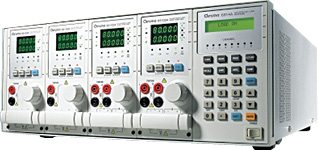
Some interesting systems in the market from Chrome Instruments (Fig. 7) for testing LED drivers include high-precision power meters, programmable DC and AC sources and LED load simulators specifically designed for LED power drivers.
With output powers ranging from 500VA to 2000VA, the 61500 series programmable AC power sources offer three different modes, namely, AC plus DC, AC and DC output modes. These feature parameters such as measure peak and inrush current, root mean square voltage, current, power, crest factor, power factor, volt-ampere, volt-ampere reactive with programmable voltage and frequency slew rate.
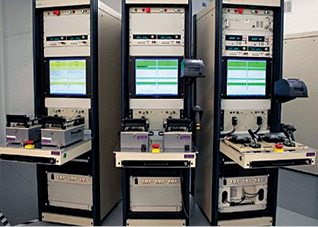
On the other hand, the Chroma 66200 series are digital power meters with a wide range of power, voltage and current parameters. A user-defined benchmark provides automatic pass or fail indications, and total harmonic distortion (THD), inrush current and other energy measurements are available.
For companies into volume manufacturing of LED drivers, fixtures and arrays, it is important to verify the quality of their production swiftly. Time-to-market is an important factor to keep in mind, apart from improving product performance, validating its design and quality.
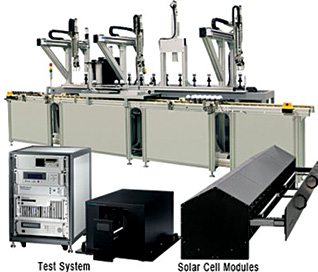
As the name suggests, ASE Test’s SSL 3.0 Test System (Fig. 8) is industry’s first automated test system for solid-state lighting products. It is basically used for design verification, volume manufacturing testing and performance validation. It tests DC-driven LED arrays, AC-driven LED drivers and LED fixtures across multiple voltages and load capabilities in 10 to 20 seconds. Manufacturers can fulfil six-sigma certifications for their products with statistical process control (SPC) delivered by this system. To help construct industry standards, this testing system also creates defined testing parameters and benchmarks for LED light engines, drivers and systems.
A test system for LED bulbs, lamps and other luminaries
This LED lighting inline test system focuses on production-line tests. Apart from basic measurement, other processes such as data collection and analysis, integration of production line and automated calibration highlight the advantages of using this system, in addition to optical and electrical T&M such as total luminous flux of LED lamps (lm), correlated colour temperature (CCT), colour rendering index (CRI), power factor (PF) and luminous efficacy (lm/W).
Spatial distribution and flicker measurement characterization are two of its core techniques. By using the angle between the LED lamp and solar cells as well as the measured parameters from solar cells, it can calculate the distribution of the optical field of the LED lamp. It can also perform measurement of a flicker of an LED lamp with the help of high-speed response of solar cells.
This test equipment is suitable for different types of LED lamps. A special module is used to measure the luminous flux of inconsistent shapes or multiple sizes of LED lamps. This equipment is also easy-to-integrate with other automated systems to observe and increase test speed and reduce measurement cost to carry out automation on production line.


Sorting and binning LEDs with a spectral meter
In the industrial manufacturing of LEDs, based on colorimetric and photometric specifications, sorting and binning LEDs generates challenges in measurement parameters such as accuracy and speed. Apart from error-free synchronisation of the spectral meter with the existing system operation, it is highly important for the measurement device to accurately obtain results and transfer the data in the shortest time possible.
Gigahertz-Optik’s BTS2048-VL spectral light and colour meter is best suited for online production applications for radiometric, colorimetric, photometric and spectral-radiometric measurements. It provides a speedy response time over a broad dynamic range using three processors and electronic shutter, coupled with input and output triggers for synchronized LED-binning applications.







I want to develop high voltage detective sensor with low cost to use every circuit
Plz contact me on ds no. 9122434706.